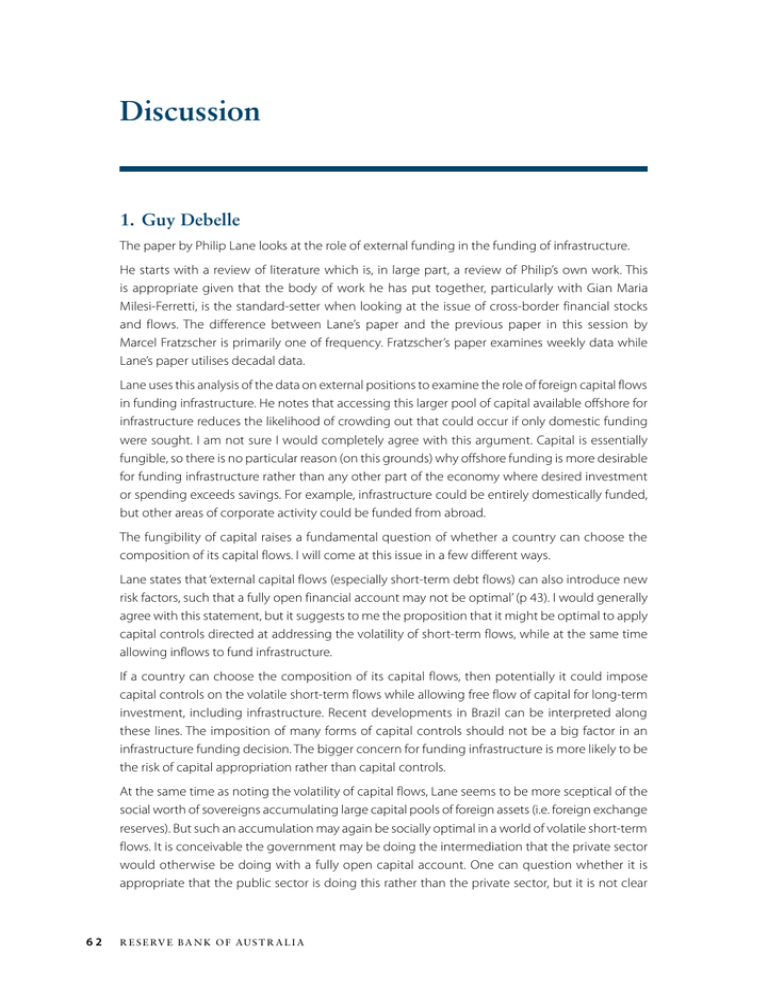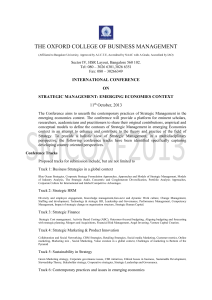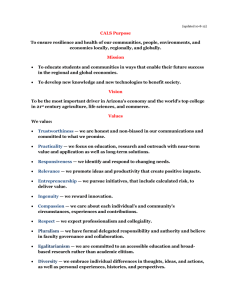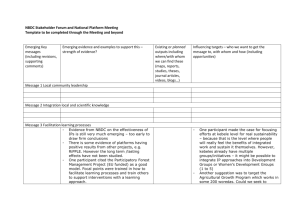Discussion 1. Guy Debelle
advertisement

Discussion 1. Guy Debelle The paper by Philip Lane looks at the role of external funding in the funding of infrastructure. He starts with a review of literature which is, in large part, a review of Philip’s own work. This is appropriate given that the body of work he has put together, particularly with Gian Maria Milesi‑Ferretti, is the standard-setter when looking at the issue of cross-border financial stocks and flows. The difference between Lane’s paper and the previous paper in this session by Marcel Fratzscher is primarily one of frequency. Fratzscher’s paper examines weekly data while Lane’s paper utilises decadal data. Lane uses this analysis of the data on external positions to examine the role of foreign capital flows in funding infrastructure. He notes that accessing this larger pool of capital available offshore for infrastructure reduces the likelihood of crowding out that could occur if only domestic funding were sought. I am not sure I would completely agree with this argument. Capital is essentially fungible, so there is no particular reason (on this grounds) why offshore funding is more desirable for funding infrastructure rather than any other part of the economy where desired investment or spending exceeds savings. For example, infrastructure could be entirely domestically funded, but other areas of corporate activity could be funded from abroad. The fungibility of capital raises a fundamental question of whether a country can choose the composition of its capital flows. I will come at this issue in a few different ways. Lane states that ‘external capital flows (especially short-term debt flows) can also introduce new risk factors, such that a fully open financial account may not be optimal’ (p 43). I would generally agree with this statement, but it suggests to me the proposition that it might be optimal to apply capital controls directed at addressing the volatility of short-term flows, while at the same time allowing inflows to fund infrastructure. If a country can choose the composition of its capital flows, then potentially it could impose capital controls on the volatile short-term flows while allowing free flow of capital for long-term investment, including infrastructure. Recent developments in Brazil can be interpreted along these lines. The imposition of many forms of capital controls should not be a big factor in an infrastructure funding decision. The bigger concern for funding infrastructure is more likely to be the risk of capital appropriation rather than capital controls. At the same time as noting the volatility of capital flows, Lane seems to be more sceptical of the social worth of sovereigns accumulating large capital pools of foreign assets (i.e. foreign exchange reserves). But such an accumulation may again be socially optimal in a world of volatile short-term flows. It is conceivable the government may be doing the intermediation that the private sector would otherwise be doing with a fully open capital account. One can question whether it is appropriate that the public sector is doing this rather than the private sector, but it is not clear 62 R e s e rv e b a n k o f Au s t r a l i a d i s c u s s i on that the stocks accumulated by the private sector would be all that different in either magnitude or composition than those accumulated by the public sector. There are a number of points to consider when thinking about the appropriate composition of infrastructure funding. The desirable nature of infrastructure funding is likely to vary with the phase of the infrastructure project. The composition of funding for the construction phase may well be quite different than that in the operation phase. The construction phase is more likely to be conducive to debt rather than equity. The different forms of funding bring with them differing risks and have different risk-sharing attributes. Some forms of funding are likely to be more resilient in different situations. Syndicated lending, which generally entails some involvement from global investment banks, brings with it the possibility of contagion in the event of a global financial shock, as was very evident in 2008 and 2009. Shorter-term debt flows are likely to be vulnerable to a sudden stop in a way that direct equity is unlikely to be. Government borrowing in foreign currency is also likely to be vulnerable to a sudden stop whereas borrowing in domestic currency is likely to be more resilient. Related to this, it is important that the funding does indeed involve risk-sharing between the provider of funding and the relevant government, and does not lead to the government underwriting all the potential losses. There is also the issue of bundling together expertise and funding. How separable are these? In practice, I think they are likely to be more separable than not. Before closing, a few points on the estimation in Lane’s paper. The paper summarises a number of regressions to explain the size of current accounts and net foreign asset positions. Back in an earlier life, I did a bit of work in this area with Hamid Faruqee at the International Monetary Fund (IMF) (Debelle and Faruqee 1996). This work formed one of the building blocks of the IMF’s Consultative Group on Exchange Rates (CGER) process. In doing that work, we discovered that a lot of the relationships between current accounts or net foreign asset positions and their various explanators might be ‘U-shaped’ rather than linear. For example, consider a measure of the stage of development. A country starts off with an underdeveloped financial system, there is little capital inflow at first as a result, but then as the financial sector deepens, the country attracts capital flows and runs a current account deficit. Then the country and its financial system mature and the country becomes a capital provider and runs a current account surplus. Or take demographics and the example of Japan. Japan has been accumulating capital and a large foreign asset position for many years to deal with the problem of an ageing population by running current account surpluses. But at some point, when the population has aged, it will start to run down the accumulated stocks and run current account deficits. There is a reasonable debate to be had as to whether that point has now been reached. So in conclusion let me highlight three points that Lane’s paper makes: •• hen it comes to cross-border stocks and flows, the gross matters much more than the W net. This is a point I very much agree with and is of paramount importance in examining the structure of the global financial system. •• T he composition of the gross flows matters. This then raises the question of whether a country can choose the composition of its capital flows. Can capital controls be placed on volatile short-term flows without affecting the ability of the country to attract infrastructure funding? C O N F e r e nc e vo l u m e | 2 014 63 disc ussion •• T he various forms of infrastructure funding bring with them different risks and different risk mitigants. Some run the risk of contagion, sudden stop or capital flight. Others don’t but may be more costly. Reference Debelle G and H Faruqee (1996), ‘What Determines the Current Account? A Cross-Sectional and Panel Approach’, IMF Working Paper No WP/96/58. 2.General Discussion The discussion began with one participant suggesting that emerging market economies’ aversion to debt inflows largely reflects the fact that these debt inflows can quickly reverse. They also noted that changes in the direction of flows are often driven by factors that are external to the economy in question (such as monetary policy actions by advanced-economy central banks). The participant then questioned why these economies were so concerned about changes in the direction of capital flows, and whether there was anything that could be done to address the problem at a fundamental level. Another participant noted that there had been a sharp decline in debt inflows to emerging markets, and asked whether this was due to supply factors or a reluctance by emerging market economies to take on debt. One participant welcomed the conclusion that long-term capital should be flowing from the northern to the southern hemisphere to fund essential infrastructure projects in emerging market economies. The participant went on to ask what a prudent level of the current account deficit would be for these economies, while also noting that it is possible to run a current account deficit for long periods of time as long as the money is used well, citing Australia as an example. Another participant contended that one of the important distinctions between the northern and southern hemispheres is that very few global banks are domiciled in the south – an issue, they speculated, that is unlikely to change even with economic growth. This could have implications for capital flows to emerging markets, particularly as the interests of the home economies tend to be placed ahead of the interests of other economies in which global banks conduct their business. Picking up on the topic of global banks, and the earlier question on the decline in debt inflows to emerging markets, Philip Lane noted that the world economy is currently in an ‘interesting’ transitional phase, with the global banks withdrawing from some of their global activities due, in part, to new bank regulations. He went on to question whether bond markets or emerging market banks (particularly the already large Chinese banks) would fill the financing gap left by the withdrawal of the existing global banks. Another participant asserted that the fungibility of capital is likely to affect statistics on the composition of capital flows and, relatedly, questioned the efficacy of capital controls. As an example, the participant described how Mexican entrepreneurs were able to circumvent restrictions on short-term offshore borrowing implemented in Mexico during its 1994 financial crisis. A Mexican entrepreneur would sell shares in their company to foreign banks under the promise that the shares would be bought back at a higher price in the near future. While this is essentially short-term (collateralised) borrowing, the two legs of this transaction would be recorded 64 R e s e rv e b a n k o f Au s t r a l i a d i s c u s s i on as equity flows. Professor Lane agreed that one of the big issues with capital flow management is the effectiveness of tactical controls – that is, targeted controls that are implemented in reaction to cyclical developments, such as those used in the 1994 Mexican crisis. He suggested that tactical controls often leave alternative channels for capital flows open, allowing financial engineering to bypass the controls. In contrast, more long-term and broad-based controls, such as those used in China, are much less likely to be circumvented. Professor Lane, partly in response to the discussant’s comments on the fungibility of capital, remarked that fungibility was a key motivation for his paper’s focus on overall capital flows as opposed to the financing of individual infrastructure projects. He argued that the source of infrastructure financing – whether domestic or foreign – is irrelevant provided that overall investment needs are being met. On the accuracy of balance of payments statistics, one participant noted that corporations in emerging market economies have increased their offshore debt issuance since 2010, resulting in balance of payments statistics underestimating these economies’ external debt liabilities. The participant remarked that the magnitude of this understatement can be relatively large, at around 6 per cent of GDP for some of the larger emerging market economies, implying that policymakers may be overlooking a relatively important source of risk. Another participant commented on the fact that the aggregate net international investment position of emerging market economies had shifted over time because many of these economies were no longer running deficits. The participant questioned how much of this change was driven by China building up large foreign exchange reserves. The participant also noted an interesting change in the composition of foreign claims. In emerging markets, the public sector has largely been responsible for the increase in foreign claims, both through holding larger foreign exchange reserves and through foreign investment by sovereign wealth funds. In contrast, in advanced economies, public debt has been increasing strongly while the private sector has become more of a net creditor. After questioning the extent to which the private sector in emerging economies had been building up foreign claims, the participant went on to propose that, in terms of foreign investment, the private sector does not seem to be particularly well diversified in emerging markets relative to the private sector in advanced economies. In response, Professor Lane stated that the shift in the net international investment position of emerging market economies had largely been driven by build-ups of official foreign exchange reserves. C O N F e r e nc e vo l u m e | 2 014 65 66 R e s e rv e b a n k o f Au s t r a l i a








